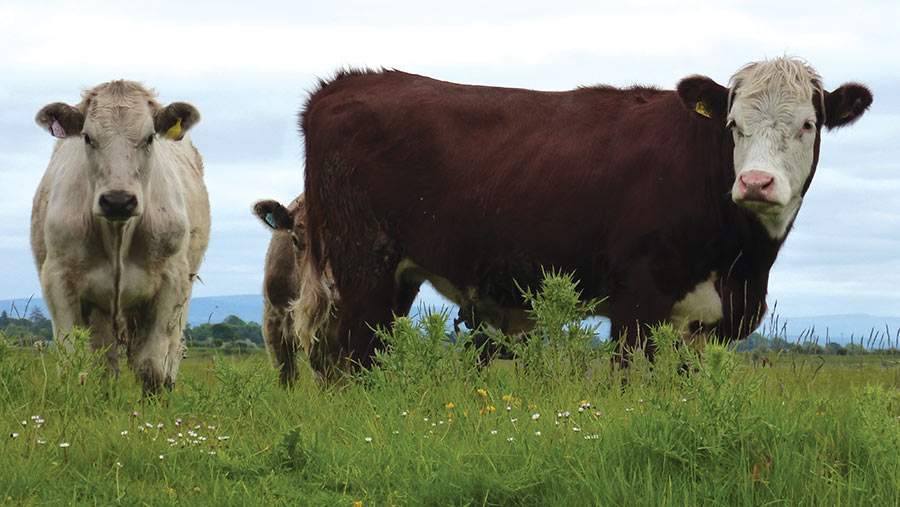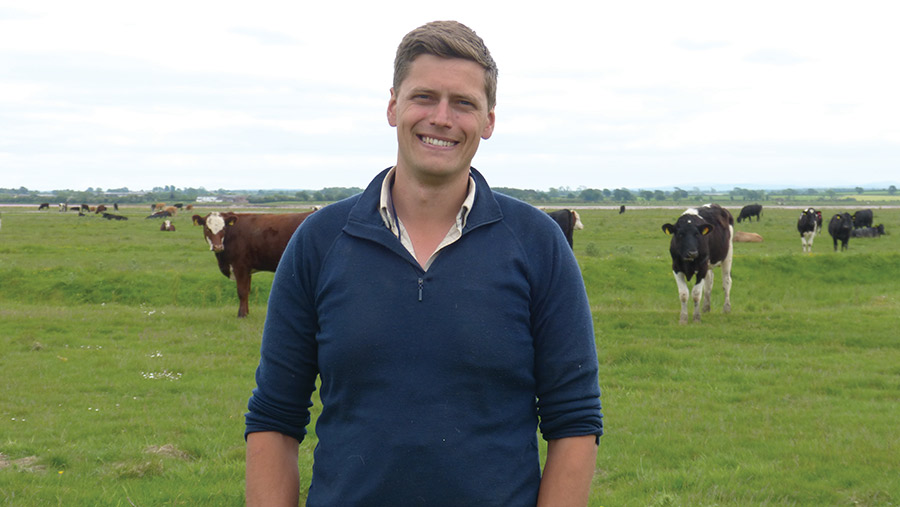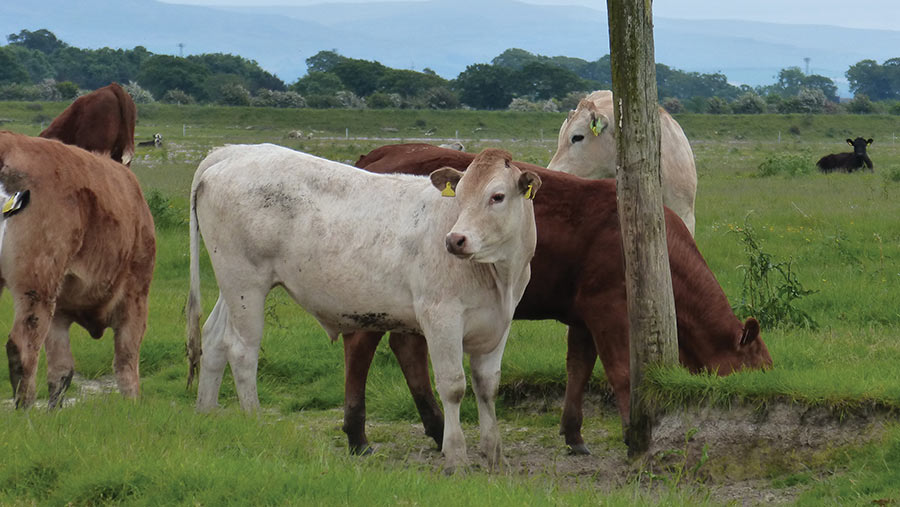Video: How a Cumbrian estate grazes beef cattle on 1,000ha marsh
 © MAG/Michael Priestley
© MAG/Michael Priestley Innovative grazing practices have enabled a Cumbrian estate to capitalise on more than 1,000ha (2,471 acres) of saltmarsh, giving a beef finishing system an extensive, low-input store period.
Each summer, the team at the Castletown Estate, near Carlisle, sends up to 1,000 cattle to graze the English side of the marshy grassland where the rivers Esk and Eden meet the Irish Sea in the Solway Firth.
See also: 4 farmers outline bale grazing benefits in field lab trial
The marsh is ideal for growing frame on cattle and can finish 85-90% of the lowland lambs the estate produces without any supplementation.
However, the area is unfenced and hazardous, with dykes, sinking sand and incoming tides that lift water levels as much as one metre in a matter of seconds.
Farmers Weekly asked how the estate team manages cattle in such a challenging landscape. Hear from Castletown farm and estate director Ruari Martin in the video and read the full report below.
Farm facts: Castletown Estate
2,630ha (6,500 acres) across two farms, employing six full-time staff
Lowland estate
- 1,821 (4,500 acres)
- Includes 243ha (600 acres) of arable with rotational grass
- 200 native-cross suckler cows
- 1,500 ewes tupped
- Up to 1,000 cattle finished annually and sold deadweight
Upland contract farming partnership
- 809ha (2,000 acres) of grassland near Lockerbie
- 1,300 ewes tupped
- Cattle rearing enterprise

Ruari Martin © MAG/Michael Priestley
Beef system
The marsh is used to grow dairy-beef cattle (mostly native-cross) from 300kg yearlings to 400-450kg, and prime lambs in a zero-input grazing system.
Cattle go on the marsh in mid-May, once ground-nesting birds have had a chance to fledge, and are brought off again in October.
This year, the estate has about 300 of its own cattle, along with 450 managed on a contract basis for other people who have rented grazing “stints”.
Daily liveweight gains on the marsh are about 0.6-0.8kg, meaning the heaviest cattle are often ready to house and finish before Christmas.
Once off the marsh, the cattle typically have a “marsh bounce”, when they gain 2-2.5kg a day for several days.
“This bounce could be down to the diversity of the rough forage on the marsh conditioning the rumen, gearing up the animal to grow quickly on a nutrient-dense finishing diet,” explains Ruari Martin.
After this period, they generally settle at 1.3kg a head a day to finish in the shed, where they are on a diet of home-grown grass silage, wholecrop beans, wholecrop barley, and crimped barley, as well as bought-in minerals and protein.
Native-crosses are taken to 550-600kg liveweight for a 300kg carcass at an O-grade or R4L.
Cattle under 450kg are put on forage crops, grown as part of the estate’s arable rotation, to finish through the winter and spring.

© MAG/Michael Priestley
Environmental system
The practice of grazing the Solway marshes is centuries old, but new opportunities across the Solway Coast area of outstanding natural beauty are developing, explains estate owner Toby Mounsey-Heysham.
Firstly, the estate’s side of the marsh is expanding by up to 24ha (60 acres) a year because of sedimentary accretion.
Three additional islands of grazing have appeared over the past 20 years, the biggest of which measures 202ha (500 acres).
Toby believes livestock have a significant role to play in carbon sequestration, biodiversity net gain and landscape management on the marsh by grazing, defecating and building organic matter.
“I think there’s a very unhelpful dichotomy that sees food production and landscape stewardship in opposition – we can have both,” he says.
“I see a future zero-carbon red meat offering, which could be exciting.
“Farming remains key for us as it generates income and produces the landscape. But we are looking at how environmental payments, small tourism diversifications, and potential carbon-sequestration payments can be layered on top of a red meat business to diversify the estate’s income for the future.”
How Castletown cattle are managed on the marsh
Routine jobs
- Cattle are bought privately in groups, weighed, vaccinated against infectious bovine rhinotracheitis and clostridials, and turned out on the marsh
- One person does a two-hour check of the marsh twice daily, checking creeks and pushing stock off low ground before tides come in
- To go the full length of the marsh and back is six miles, and typically requires half a tank of petrol for the quad bike, so machines are always filled up beforehand
- No mineral or supplementary feeding is given to stock on the marsh, as the diverse range of grasses and herbs provides a varied diet
- The Liverpool and Irish tide timetable is checked regularly for high tides
- Monthly high tides are used as an opportunity to gather all stock (done by three people and three dogs), draft off any stronger cattle into the fattening shed (from July/August onwards) and do other jobs (weighing, treating sick stock and so on)
- No wormers have been given to the stock while on the marsh, as the regular tides leave clean pasture, as shown by faecal egg counts (fewer than 50 eggs/g). Lameness issues are minimal and mainly caused by driftwood
Rescue jobs
- Up to 10 cattle each summer and two to three sheep a week are found stuck in quicksand. Wooden boards are used to reach the animal, and driftwood, ropes and straps used to help the animal to safety
- If an animal is stuck deep, a petrol-powered pressure washer and water tank is used to flood the sand, loosening the animal
- A big rescue job can take two to four hours
- A 9m tide will typically cover the entire marsh, meaning a prompt and complete evacuation of stock is required that month. If freshwater rivers are high and there is a prevailing westerly wind, the tide can encroach onto in-bye ground
- Cattle and sheep are moved off the marsh to safer ground to mob-graze a paddock for 24-96 hours behind a bank until the tide subsides
Infrastructure
- The marsh boundary is bordered by the rivers Eden and Esk, and an internal boundary is fenced to minimise fox and badger predation
- There are 12 water troughs on the marsh – six 1,364-litre concrete troughs and six 682-litre troughs. Salt water and deposits, and no shade, mean water sources are important
- Three marshes make up the farmed area (Rockcliffe, Garriestown and Demesne). Each has known landmarks, islands and watercourses that are mapped to help staff navigate them
- Watercourses and ditches are commonplace, slowing down the progress of quad bikes and pickups. Small bridges are made with concrete pipes and mud at strategic points to help staff check stock more easily
- Bridges are marked by large tree trunks sticking 2-4m out of the ground
- A low stocking rate of less than 0.5 livestock units/ha gives birds space and cover to thrive. Stock are fenced off from a 12ha (30-acre) gull colony
Hefting
- Cattle undergo a hefting process after turnout, training them to return to the safety of in-bye ground. Each evening, the cattle are rounded up and walked back to a 202ha (500-acre) fenced area closer to dry land. Electric spring gates release automatically to let them back onto the marsh
